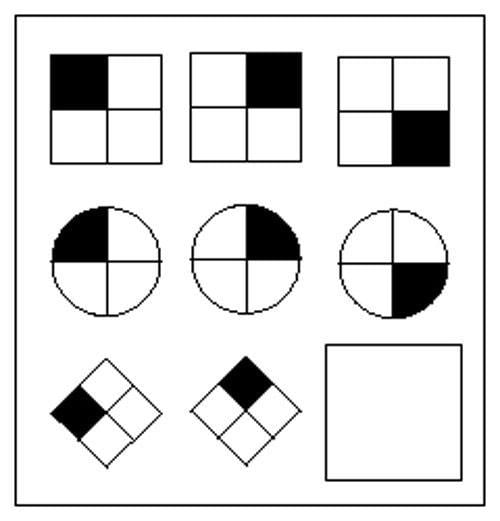- HubPages»
- Education and Science»
- Psychology & Psychiatry»
- Personality Theory & Personality Tests
Your IQ: What Questions Are In IQ Tests?
What Is in an Intelligence Test?
Everyone has been bated by pop-up banner messages advertising free IQ tests, but what really goes into an IQ test? We all agree that intelligence is a good thing, but who can describe it? Is knowledge the same as intelligence? Psychologists and philosophers have long struggled to define intelligence. Schools and the military started using precursors of modern intelligence tests around World War I to identify mentally challenged students and screen recruits. They continue to be used in schools to establish giftedness or the need for remedial assistance, and occasionally in criminal proceedings to determine if defendants are competent. Scientists over the last century have developed tests to measure it, but what is it they measuring?
There is no one universal test for intelligence. Psychologists have developed several different tests based on slightly different theories about what constitutes intelligence and to address problems some test takers may have stemming from specific communication skills. What all of these tests have in common is the goal of testing mental skills, with a minimum of acquired knowledge. Ideally, one should not be able to study for an intelligence test; the test should strictly evaluate ability or problem-solving performance.
The Stanford-Binet Tests
The Binet-Simon intelligence test was the earliest of modern intelligence tests. It was initially developed by the French psychologists Alfred Binet and Theodore Simon to test children for mental deficits. German psychologist William Stern proposed scoring intelligence based on a quotient of Binet’s concept of mental age and chronological age, hence the “quotient” part of the term “intelligence quotient.” American psychologist Lewis Terman of Stanford University created a revised version of the Binet-Simon test, and the test became known as the Stanford-Binet test. Terman served in the U.S. Army during World War I and oversaw a wide expansion of the use of IQ tests.
The Wechsler Tests
Today, the Wechsler Adult Intelligence Scale IV (WAIS-IV) is the most widely used adult intelligence test in the world. The Stanford-Binet tests were developed to evaluate children’s intelligence. Dr. David Wechsler worked as a clinical psychologist and saw the Stanford-Binet tests as irrelevant to adult intelligence. Wechsler’s adult test did not use the mental age concept for rendering a quotient, but used a percentile scoring method. Wechsler focused on intellectual performance. To Wechsler, intelligence was “The global capacity of a person to act purposefully, to think rationally, and to deal effectively with his/her environment.” Ability did not matter if it could not be used adaptively.
The Structure of the Wechler Adult Intelligence Scale IV
The most recent revision of the Wechsler adult intelligence test has four main components: verbal comprehension, perceptual reasoning, working memory, and processing speed. Each is elaborated below:
Verbal Comprehension. This portion contains four subtests: three “core” items on similarities, vocabulary and information, and a supplemental subtest on comprehension. The similarities subtest tests abstract verbal reasoning, e.g. “How are a bat and a bird similar?” The vocabulary tests knowledge of, and ability to express everyday vocabulary items. The information subtest tests general information, e.g. “What is the Capital of California?”
The Perceptual Reasoning Scale. The core subtests involve block design, matrix reasoning, and visual puzzles. The block design subtest is a timed test where the subject arranges colored blocks in specified patterns. Matrix reasoning involves non-verbal problem solving, for instance determining which shade should come next based on a series of abstract shapes. Visual puzzles involve non-verbal tasks such as combining pieces to assemble a picture.

Working Memory Scale. The working memory scales evaluate digit span, that is, the ability to recall and recite back strings of numbers, and perform mental arithmetic. Subjects are asked to work with numbers without a pen and paper.
Processing Speed Scale. These subtests measure speed, accuracy and attention. There is a symbol search where subjects indicate the presence of a symbol in a row and a “coding” subtest, i.e. transcribe a digit-symbol code. The tests are time limited and higher scores are given for speedier results.
True IQ tests, such as the Wechsler or Stanford-Binet tests, should only be administered and evaluated by trained professionals. Online so-called IQ tests are typically knowledge tests or simply advertising teasers.
Other Hubs by Brupie
- How to Ace a College Introductory Class
Getting good grades in the early classes is the best foundation for later success in school. Students anxious for a good grade may badger their professors on what is or isn't on the next test, but miss out on some early, simple preparations that cou - How to Become a Stockbroker
No one has a bachelor's degree in - Chasing Mispriced Stocks: How Inferior Goods Companies McDonalds & Family Dollar Store Won
Only a footnote in economics textbooks, "inferior goods" are goods and services that consumers buy more of when they have less money unlike "normal goods". When recessions come along, companies that provide "inferior goods" have a leg up on the rest - Choosing the Right Words: Using and Keeping the Right Tone
When you write, word choice is more than basic grammar and correct usage, establishing the appropriate tone and sticking to it are critical. - Picking a Food Thermometer: Bimetallic, Thermistor, ...
Instant Read Thermometers Do you know if its done yet? Most home cooks will check the doneness of meat by visual clues. They'll examine the color of the meat or if the juices run clear. Unfortunately, neither the absence of blood nor...




